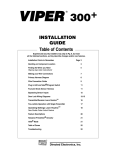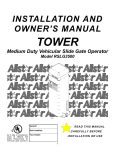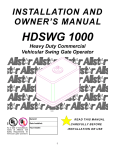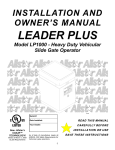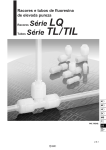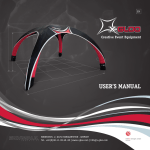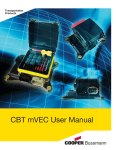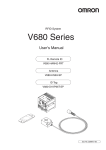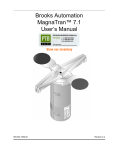Download Allstar ANSI/UL 325 Owner`s manual
Transcript
INSTALLATION AND OWNER’S MANUAL HDSLG 1000 Heavy Duty Vehicular Slide Gate Operator 104888 READ THIS MANUAL Serial #: Date Installed: As of date of manufacture, meets all ANSI/UL 325 Safety Requirements for Vehicular gate operators CAREFULLY BEFORE Your Dealer: INSTALLATION OR USE 1 TABLE OF CONTENTS Pre-Installation Notes ............................................................................ 3 Section A: Installation Notes................................................................ 4 Section B: Preparing the Site ............................................................... 6 The Concrete Operator Pad ....................................................... 6 Electrical Power Requirements ................................................ 6 Attaching the Chain Bracket...................................................... 7 Placing the Vehicle Detector Loops .......................................... 8 Section C: Installing the Operator ....................................................... 9 Placing the Operator .................................................................. 9 Electrical Hookup ....................................................................... 9 Accessory Equipment Hookup ................................................ 10 Bi-Parting Application .............................................................. 12 Wiring Diagram ......................................................................... 13 Terminal Strip Reference Chart ............................................... 14 Section D: Starting the Operator ....................................................... 15 Left or Right Hand Installations............................................... 15 Setting the Limit Switches ....................................................... 16 Setting the Obstruction Detection........................................... 16 Setting the Switch Selectable Options.................................... 17 Final Setting of Limit Switches ................................................ 19 Setting the Close Timer ........................................................... 19 Final Setting of the Obstruction Detection ............................. 19 Testing the Operator Lock ....................................................... 19 Maximum Run Timer ................................................................ 19 Final Setting for Bi-Parting Installations................................. 19 Fuses ......................................................................................... 20 Section E: Auxiliary Equipment ......................................................... 20 Section F: Safety Guide ...................................................................... 21 Operator Exploded View & Parts List ................................................. 23 Technical Specifications ..................................................................... 24 READ THESE STATEMENTS CAREFULLY AND FOLLOW THE INSTRUCTIONS CLOSELY. The Warning and Caution boxes throughout this manual are there to protect you and your equipment. Pay close attention to these boxes as you follow the manual. WARNING CAUTION WARNING CAUTION Indicates a MECHANICAL hazard of INJURY OR DEATH. Gives instructions to avoid the hazard. Indicates a MECHANICAL hazard of DAMAGE to your gate, gate operator, or equipment. Gives instructions to avoid the hazard. Indicates an ELECTRICAL hazard of INJURY OR DEATH. Gives instructions to avoid the hazard. Indicates an ELECTRICAL hazard of DAMAGE to your gate, gate operator, or equipment. Gives instructions to avoid the hazard. 2 PRE INSTALLATION NOTES increase in motor current above that normally required to move the gate. THE OVERLOAD DETECTION POINT IS AN ADJUSTABLE SETTING THAT MUST BE DETERMINED AT THE TIME OF INSTALLATION. THIS SETTING MUST BE TESTED PERIODICALLY TO ENSURE PROPER OPERATION. THE MORE FREELY THE GATE WILL MOVE THE MORE SENSITIVE THIS SETTING CAN BE MADE. See Page 17. The Allstar HDSLG 1000 Vehicular Gate Operator will provide convenience and assurance to the ultimate users for many years. It is ruggedly built of the finest materials and has been thoroughly inspected and tested at the Allstar factory. It has many features that will aid in the installation and testing of the complete gate system. The HDSLG has been evaluated by Underwriters Laboratory, Inc. (UL) and is certified to comply with UL Standard for Safety 325, as evidenced by the UL symbol on the name plate. Because the HDSLG (as well as gate operators sold by other ADVISE THE PURCHASER TO CHECK THE SENSITIVITY NOTICE NOTICE BEFORE ATTEMPTING INSTALLATION, READ THIS MANUAL CAREFULLY SO YOU WILL BE THOROUGHLY FAMILIAR WITH THE FEATURES OF THE LEADER AND ITS PROPER INSTALLATION PROCEDURES. THE IMPORTANT SAFEGUARDS AND INSTRUCTIONS IN THIS MANUAL CANNOT COVER ALL POSSIBLE CONDITIONS AND SITUATIONS WHICH MAY OCCUR DURING ITS USE. IT MUST BE UNDERSTOOD THAT COMMON SENSE AND CAUTION MUST BE EXERCISED BY THE PERSON(S) INSTALLING, MAINTAINING AND OPERATING THE EQUIPMENT DESCRIBED HEREIN. DO NOT USE THIS EQUIPMENT FOR ANY OTHER THAN ITS INTENDED PURPOSE — OPERATING A SLIDE GATE. manufactures) is designed to start and move gates weighing as much as 1200 pounds, or more,---the HDSLG is capable of producing high levels of force. It is important in the design of the total gate system that designers, installers and users be aware of the hazards that may be associated with the IMPROPER design, installation and use of vehicular gate systems and gate operators. The gate operator is only one part of a complete automatic gate operating system. As each location and usage is different, a properly designed system will include all applicable safety devices. As the designer and installer of the GATE SYSTEM, you must advise the purchaser on the proper use of the gate system. You also have the primary responsibility of insuring that ALL possible operational hazards have been considered and eliminated. YOU MUST ADVISE AND WARN the purchaser and the ultimate user of ANY HAZARDS that you have not been able to eliminate. The HDSLG has several features that can help reduce the hazards of your gate system. The Allstar HDSLG has a built-in "overload detector" that can help reduce the hazards of your gate system. This device, however, must not be considered as the primary obstruction sensing system. Consider all available options (electric leading edges, photoelectric sensors, protective screen mesh, etc) to eliminate hazards in your gate system design. The HDSLG built-in overload detector will activate if there is an abrupt OF THE OVERLOAD PERIODICALLY AND RECORD THE DATE TESTED ON THE LOG PROVIDED BELOW (See Figure 1). The HDSLG has a maximum motor current trip mechanism. If the motor current is maintained at or near maximum for a period of approximately two seconds the power will be turned off to the motor. (This situation could occur if the gate becomes jammed.) The HDSLG has a Maximum Run Timer. If the gate is activated and no other command is given or an end limit (open or close) is not reached in approximately 45 seconds, the operator will be turned off. (See Page 19) The HDSLG has an auxiliary “alarm” relay that can be used to give a WARNING when the gate is opening or closing or if the OVERLOAD has been activated. TO USE THIS ALARM FEATURE WILL REQUIRE THAT THE INSTALLER PROVIDE THE ALARM MECHANISM AND THE ELECTRICAL POWER FOR THE ALARM. See Page 17. W A R N I N G H I G H V O LTA G E ONLY A QUALIFIED TECHNICIAN SHOULD SERVICE THIS GATE OPERATOR PERIODICALLY TEST SENSITIVITY OF OVERLOAD *** READ MANUAL *** LOG DATE OVERLOAD TEST DATE TESTED DATE TESTED DATE TESTED DATE TESTED DATES OPERATOR SERVICED Figure 1 3 A: IMPORTANT INSTALLATION NOTES WARNING! TO REDUCE THE RISK OF SEVERE INJURY OR DEATH: READ AND FOLLOW ALL INSTALLATION INSTRUCTIONS AND GATE SYSTEM DESIGN PARAMETERS! GATE SYSTEM DESIGN AND INSTALLATION SAFETY CHECK LIST: • DO NOT locate any device (key switch, switch, key pad, card reader, etc.) in a position where it may be activated by a person reaching through the gate or while touching the gate in any manner. • Install all devices that will open or close the gate in such a manner that THE GATE WILL BE IN FULL VIEW WHEN THE DEVICE IS OPERATED. • SECURELY ATTACH THE WARNING SIGNS provided with the HDSLG on the gate (one on the outside and one on the inside) where they can be seen by persons in the area of the gate to alert them of automatic gate operation. (If the user refuses to have the warning signs installed, Allstar recommends you note this on your records and have the user sign a disclaimer.) See Figure 2. Figure 2 • • • 104949 Figure 3 • CANTILEVERED ROLLER GATES WITH OPEN ROLLERS HAVE THE POTENTIAL HAZARD OF HANDS AND FINGERS BEING PINCHED between the open roller and the pole that the roller rides upon. PROTECT THIS "PINCH POINT" SO THIS HAZARD IS AVERTED. See Figure 4. • CONSIDER ALL OTHER "PINCH POINTS" IN YOUR DESIGN of the gate system, such as the “pocket” of a sliding gate. Use protective measures to reduce hazards at these locations. See Figure 4. • When using the “timer to close” option of the HDSLG, install VEHICLE DETECTOR LOOPS, VEHICLE DETECTORS, REVERSING EDGE SYSTEMS AND/OR PHOTOCELLS. Read the manual for information on the installation of these devices. IF VEHICLE DETECTOR LOOPS HAVE BEEN INSTALLED TO PREVENT THE GATE FROM CLOSING ON A VEHICLE, INSTRUCT THE USER TO PERIODICALLY CHECK THE OPERATION OF THE DETECTORS. • Outdoor or easily accessible controls must be of the security type to prevent unauthorized use of the system. • Make sure the gate operating system is placed far enough back from the road to eliminate traffic backup. The distance from the road, size of the gate, usage level and gate cycle/speed must be taken into consideration to eliminate potential hazards. • Check the operator manufacturer’s specification to ensure the operator is proper for the cycles per hour, size and type of gate. • USE EXTREME CAUTION WHEN WORKING NEAR BELTS AND PULLEYS when the operator cover is removed. Apply power to the operator only when instructed to do so. • Before activating the "timer to close" option of the operator, ENSURE THE PERSONAL ENTRAPMENT DEVICES 104880 FOR INSTALLATIONS WHERE IT IS LIKELY CHILDREN WILL BE PRESENT NEAR THE AUTOMATIC GATE, PLACE A WARNING SIGN SPECIFICALLY DIRECTED TO PARENTS AND VISITORS TO KEEP CHILDREN AWAY FROM THE GATE AND NOT ALLOW CHILDREN TO PLAY ON THE GATE. (If the user refuses to have the sign installed, Allstar recommends you note this on your records and have the user sign a disclaimer.) See Figure 2. For ORNAMENTAL “GRILL TYPE” GATES, injuries may occur when people put arms through the openings or children “ride” the gate by standing on the chain and holding on to the gate. THIS POTENTIAL HAZARD CAN BE MINIMIZED BY INSTALLING A MESH SCREEN ON THE GATE. See Figure 3. The HDSLG 1000 is a VEHICULAR GATE OPERATOR and as such is NOT RECOMMENDED FOR PEDESTRIAN traffic. In installations where pedestrians are likely to be nearby, install a pedestrian gate and use leading edge detectors and/or photocells in your design to protect system entrapment zones. Allstar can provide these products for incorporation in your gate installation. 4 A: IMPORTANT INSTALLATION NOTES (operator reversing feature, edges, photocells) ARE OPERATING and install VEHICLE DETECTOR LOOPS AND VEHICLE DETECTORS for protection of user vehicles. Read the manual for information on the installation of these devices. IF VEHICLE DETECTOR LOOPS HAVE BEEN INSTALLED TO PREVENT THE GATE FROM CLOSING ON A VEHICLE, INSTRUCT THE USER TO PERIODICALLY CHECK THE OPERATION OF THE DETECTORS. • Make sure the gate moves freely, all hinges are in good working order, the gate does not bind in any manner and the gate swing area is clean and free of irregularities. • The HDSLG 1000 is shipped from the factory with the sprocket guard in place. When operating the gate with the operator’s outer cover removed, STAY CLEAR OF THE DRIVE SPROCKET AND IDLER PULLEYS. THESE PINCH POINTS WILL NOT BE PROTECTED WHEN THE COVER IS REMOVED. NEVER LEAVE THE INSTALLATION WHEN THE COVER IS REMOVED AND THE GATE MAY BE OPERATED. • NEVER LEAVE THE INSTALLATION SPROCKET GUARD IS REMOVED. • When the metal cover of the control box is removed, 115 Volts AC will be exposed on the control board AS LONG AS THE MAIN POWER SWITCH IS ON. EVEN IF THE RED POWER LIGHT ON THE CONTROL BOARD IS NOT LIGHTED, 115 VOLTS AC WILL STILL BE PRESENT ON THE CONTROL BOARD. NEVER LEAVE THE INSTALLATION WITH THE COVER OF THE CONTROL BOX REMOVED. WHEN THE • ALWAYS TURN OFF THE POWER BEFORE REPLACING THE SNAP-IN FUSES ON THE CONTROL BOARD. • DO NOT TRIM THE PLASTIC SPROCKET GUARD COVER MORE THAN IS NECESSARY TO CLEAR THE ENTRANCE AND EXIT OF THE CHAIN. THERE ARE SCORE MARKS ON THE COVER FOR THE PROPER “CUT-OUT”. UL Listing was obtained with the sprocket guard cover trimmed as marked on the cover. You may void the UL Listing and increase the pinch hazard if the trim lines are not followed.. • DO NOT INSTALL THE OPERATOR UNTIL ALL GATE PROBLEMS HAVE BEEN CORRECTED. • DO NOT consider the built in overload detector as the primary obstruction sensing system. Consider all options in the gate system design. • DO NOT connect any auxiliary equipment to the operator (detectors, card readers, etc.) until the gate operator and all its functions are fully tested. Only connect one device at a time and ensure its proper function(s) before moving on to the next device. • Install the operator on the inside of the property/fence line. DO NOT install an operator on the public side of the fence line or gate. • IDENTIFY THE ENTRAPMENT ZONES AND PINCH POINT AREAS PER FIGURE 4. Design the gate installation to minimize the risk of entrapment in these areas. Install additional safety equipment such as four wire edges and photocells to further minimize risk. All entrapment zones are required to be protected. AS THE INSTALLER YOU ARE RESPONSIBLE FOR: • ASSURING THAT THE OWNER/END USER OF THE SYSTEM UNDERSTANDS ITS BASIC OPERATION AND SAFETY FEATURES. IN PARTICULAR, BE SURE THE OWNER/END USER UNDERSTANDS THE LOCATION AND OPERATION OF A MANUAL DISCONNECT (WHERE PROVIDED) OR HOW TO OPERATE THE GATE MANUALLY. • POINTING OUT TO THE OWNER/END USER OF THE GATE SYSTEM THAT CHILDREN OR PETS ARE NOT ALLOWED TO PLAY ON OR NEAR THE GATE, FENCE OR ANY PART OF THE SYSTEM, AND THAT THE SAFETY INSTRUCTIONS SUPPLIED WITH THIS OPERATOR AND THEIR IMPLEMENTATION ARE THE RESPONSIBILITY OF THE OWNER/END USER. • LEAVING THE INSTALLATION AND MAINTENANCE MANUAL FOR THIS OPERATOR AS WELL AS ANY ADDITIONAL SAFETY INFORMATION SUPPLIED WITH THIS OPERATOR OR OTHER COMPONENTS OF THE GATE SYSTEM WITH THE OWNER/END USER. 106709 • NOT PLACING IN SERVICE THIS OPERATOR IF YOU HAVE ANY QUESTIONS ABOUT THE SAFETY OF THE GATE OPERATING SYSTEM. CONSULT THE OPERATOR MANUFACTURER. SLIDE GATE ENTRAPMENT PROTECTION Use the illustration at left to minimize the risk of injury in your design of the swing gate operator system. Entrapment Zones: Design in personal entrapment protection devices to protect people from entrapment in the zones shown. Install vertical posts with gate edges attached on both sides of the gate to prevent body entrapment. Gate edges should be wired to stop the gate upon contact. Pinch Points: Attach roller guards in cantilevered gate systems to minimize the risk of hands being caught between the top of the gate and the roller. Figure 4 5 B: PREPARING THE SITE THE CONCRETE OPERATOR PAD If a suitable concrete base already exists for mounting the operator it will be necessary only to drill mounting holes. 3/4" mounting holes are located on each side of the operator. Four redhead bolts, 3/8" or 1/2" in diameter, should be used for mounting the operator. The bolt pattern is 10" wide by 16-3/4" long. The two rear bolts, (closest to the gate), should be no closer than 3-5/8" from the near side of the gate to allow sufficient clearance for the operator's cover. Installation requires the presence of a suitable concrete pad as a base for the operator. The dimensions of this pad should be sufficient to allow at least 6" of clearance from each edge of the pad to the nearest operator mounting hole. The top of the pad should be 3" above grade to raise the operator above any standing water, while the depth of the pad below grade is dependent on the weight and size of the gate and the soil conditions at the site of the installation. THE SITE FOR THE OPERATOR SHOULD BE CHOSEN WITH AT LEAST 5" OF CLEARANCE ABOVE THE TOP OF THE UNIT. 104883 Figure 6a: Parallel Placement ELECTRICAL POWER REQUIREMENTS NOTE: Before connecting the operator, use a voltmeter to insure that the electrical service is 115 VAC. Connection to 220 VAC service is the most common cause of board failure in new WARNING! AVOID ELECTROCUTION: DO NOT ROUTE LOW VOLTAGE WIRES IN SAME CONDUIT AS HIGH VOLTAGE WIRES. FOLLOW ALL LOCAL ELECTRICAL CODES OR THE NATIONAL ELECTRICAL CODE. 104881 Figure 5: Pad Configuration If no suitable concrete base exists, a pad must be poured. See Figures 5 and 6 for plans for this pad. Consult local building codes for depth of base. Typical depths range from 24 to 36 inches. In either case, if vehicles are going to be operated in the vicinity of the operator, consider installation of protection posts in front of the operator. installations and is NOT covered by the warranty. 104882 The operator requires a 3-wire (Hot, Common, Ground), 115 VAC, electrical circuit with a 15 Amp breaker for proper operation. In installations with more than one operator, each operator must have a separate service from the breaker panel. Powering multiple operators from the same service can result in having to "de-sensitize" the Figure 6: Operator Footprint 6 WIRE SIZE NOMINAL DISTANCE MAXIMUM DISTANCE #14 #12 #10 #8 #6 #4 #2 100’ 150’ 250’ 400’ 600’ 1000’ 1600’ 200’ 300’ 500’ 800’ 1200’ 2000’ 3200’ B: PREPARING THE SITE obstruction sensing adjustment to prevent one operator from overloading the other. The electrical hookup is made in the junction box located in the right front corner of the frame. See Figure 7, Page 7. 104888 Figure 7: Service Conduit NOTICE: The Installer is responsible for guarding the The AWG wire size for the electrical service depends on the distance of post mounted Idler Sprocket in back drive installations. the operator from the breaker panel. Refer to the table below to determine the correct wire size. The NOMINAL column is the ideal distance from the breaker panel to the operator for a given wire size. The distances shown in the MAXIMUM column should never be exceeded. For distances greater than 3200', it is recommended that your local utility be contacted to install a service feeder for the installation. 106729 106728 Figure 8: Chain Configuration - Normal Drive 7 Figure 9: Chain Configuration - Back Drive B: PREPARING THE SITE Figure 10: Loop Diagrams 104886 WARNING! RISK OF ENTRAPAMENT VEHICLE DETECTOR LOOPS WILL NOT DETECT SMALLER VEHICLES SUCH AS MOTORCYCLES OR GOLF CARTS, OR BICYCLES OR PEDESTRIANS. PHOTOELECTRIC DETECTORS, EDGE DETECTORS AND SEPARATE PEDESTRIAN ACCESS MUST BE INSTALLED. Wiring from external controls such as guard shack, telephone entry, keypad or card reader systems should be brought to the operator by a conduit separate from the 115 VAC electrical hookup. Low voltage control wires MUST NEVER be routed in the same conduit as A.C. power wires. Always consult and follow all local electrical codes. ATTACHING THE CHAIN BRACKET The chain brackets provided with the operator should be mounted on the the gate with the centerline of the slot 8" above the top of the operator pad. Attach one end of the chain to the gate and thread the other end through the idler pulleys and drive sprocket. Attach the free end to the bracket on the gate and tension the chain. You will normally require a welder, or an electric drill with a 3/8" bit, for attaching the chain brackets to the gate. See Figures 8 and 9. 8 C: INSTALLING THE OPERATOR TOOLS REQUIRED The following tools and materials are required for proper installation of the operator: 3. Wire cutter, stripper and crimping tools. (For attaching accessory equipment to the control box barrier strip.) 4. Standard screwdriver. (For junction box face plate.) 5. Very small standard screw driver. (For adjusting controller board trimmer potentiometers.) 6. Phillips head screwdriver. (For control box face plate.) Two 3/4" wrenches. (For tightening hex nuts on the chain take-up bolts.) 2. Chain cutting tool. (For adjusting chain length.) UNPACKING CHECKLIST The following is a check list of the various parts included with the operator: 1. 1 HDSLG 1000 Gate Operator w/Cover 4. s 2. 2 Cover Lock Keys 4. 2 Chain Brackets 5. 1 Chain Take-up Bolt Kit 3. 3. 6. 2 Gate Warning Sign PLACING THE OPERATOR ELECTRICAL HOOKUP The recommended procedure for attaching the operator to the concrete pad is first to locate and drill the hole for the right rear redhead. Review Figure 6, Page 6. After placing the redhead in the hole, remove the cover and lower the operator over the redhead. Make sure the two rear mounting holes on the operator are exactly the same distance from the gate. (Improper alignment of the operator will cause premature chain and idler sprocket failure.) With the operator properly aligned with the gate, drill the remaining three holes with the operator in place. The operator requires a 3-wire, 115 VAC electrical hook-up for proper operation. Ideally, the conduit containing the hook-up wires should exit the concrete pad under the operator. Run flexible conduit from the point where the conduit exits the pad and attach it to the bottom of the junction box at the front of the frame. Review Figure 7, Page 7. If the hook-up exits the pad external to the operator, there's a 7/8" diameter hole in each side of the frame near the front of the operator. Review Figure 7, Page 7. Before inserting the remaining redhead bolts, make sure the operator is sitting level. If any corners of the operator are resting above the pad, slide flat washers under the operator and insert the redhead through the washers. Place the flat washers, lock washers and nuts on the redhead bolts and tighten down the operator securely. Remove the junction box face plate. Using the wire nuts provided, attach the three lead wires to the electrical hook-up wires in the following manner: WARNING! RISK OF ELECTROCUTION DO NOT BEGIN THE ELECTRICAL CONNECTION PROCEDURES UNTIL THE POWER IS TURNED OFF AT THE CIRCUIT BREAKER 9 1. The BLACK wire attaches to the 115 VAC HOT wire. 2. The WHITE wire to the 115 VAC NEUTRAL wire. 3. The GREEN wire to the GROUND wire. C: INSTALLING THE OPERATOR NOTE: The control board comes equipped with a built-in surge protector which MAY prevent damage to the controller board in the event of a nearby lightning strike or a surge in the power lines. For the surge protector to function, and as a general precaution, the operator must be properly grounded. The third wire for the ground must be installed . ADDITIONAL LIGHTNING PROTECTION For those areas where a high probability of ground lightning strikes exists (Florida, Georgia, etc.), additional lightning protection should be installed. Although it may not be possible to protect against all strikes, additional protection will substantially reduce the occurrence of lightning damage. Allstar’s lightning data indicates that the most strikes enter the operator through the power lines. Effective protection requires that the surge current from the lightning strike be shunted to ground. This must be done without raising the potential of the circuitry in the operator, with respect to ground, to the levels that will damage the solid state circuitry. Lightning strikes generate enormous currents for very short periods of time. Unfortunately, the period of time is long enough to damage solid state components and many times, other components. The key to success is a very low resistance path from the surge protector to ground for these currents in addition to a surge protector that will act fast enough to protect the solid state circuitry. Several manufacturers offer suitable surge protectors. WARNING! TO REDUCE THE RISK OF DAMAGE DUE TO LIGHTNING, ENSURE A SOLID GROUND FROM THE GROUND WIRE IN THE SERVICE ENTRANCE 2 x 4 HANDY BOX TO THE ELECTRICAL SERVICE GROUND OR TO A EARTH GROUND STAKE NEAR THE LEADER 107847 WARNING! IMPROPER WIRING COULD CAUSE ELECTROCUTION OR DAMAGE TO CIRCUITRY. FOLLOW LOCAL BUILDING AND ELECTRICAL Figure 11: Terminal Strip 10 C: INSTALLING THE OPERATOR ACCESSORY EQUIPMENT HOOK-UP 104890 104891 Figure 12: Wiring a 4-Wire Receiver Figure 11: Wiring a 3-Wire Receiver All accessory equipment is hooked-up to the 11 position terminal strip located in the control box. See Figure 11. NO ACCESSORY EQUIPMENT SHOULD BE INSTALLED IN THE CONTROL BOX! If local electrical codes permit, use the operator's bottom plate for mounting accessory components. Otherwise, install the accessory equipment in an appropriate electrical box. The command inputs for the operator require a switch closure to COMMON of less than 100 OHMS resistance and for more than 100 milliseconds duration. The inputs - HOLD OPEN, REVERSING & STOP - can be continuous signals. A label on the control box lists the function of each of the terminals on the barrier strip. See the Reference Chart on Page 14. WIRING VEHICLE DETECTORS Place the detector on the bottom plate of the frame or in a remote electrical box, NEVER in the control box. Hook-up the power and loop wires on the detector harness according to the manufacturer's instructions. Crimp 1/4" quick disconnect lugs to the RELAY COMMON and PRESENCE OUTPUT wires on the detector harness. The RELAY COMMON wire is connected to terminal #1, COMMON, on the control box 11 position terminal strip. The PRESENCE OUTPUT wire is connected to terminal #8, REVERSING. See Figure 10, for a typical installation. Set the detector frequency and sensitivity switches on the detector according to the manufacturer's instructions. WIRING FREE EXIT DETECTORS The installation of a free exit loop detector is identical to a vehicle loop detector with the following exceptions: Connect the PRESENCE OUTPUT wire of the detector wiring harness to terminal #2, HOLD OPEN, on the terminal strip. The RELAY COMMON wire is connected to terminal #1. WARNING! 11 RISK OF ENTRAPMENT! TO REDUCE THE RISK OF INJURY OR DEATH: LOCATE KEYPAD, CARD READER, KEY SWITCH OR SIMILAR ENTRY DEVICES IN A LOCATION WHERE A USER CAN NOT REACH THROUGH THE GATE OR FENCE TO ACTIVATE THE GATE OPERATOR. THE RECOMMENDED DISTANCE BETWEEN THE GATE OR FENCE C: INSTALLING THE OPERATOR ancillary equipment such as a radio, loop detector or card or key pads. WIRING RADIO RECEIVERS An auxiliary transformer mounted on the AC input junction box IF THE AUXILIARY TRANSFORMER IS USED TO POWER A RADIO RECEIVER, THEN, NO OTHER EQUIPMENT MAY BE CONNECTED TO THE AUXILIARY TRANSFORMER. When a radio receiver is connected to the transformer for power, one end of the receiver relay must be connected to the common terminal on the barrier strip. This will effectively ground one side of the auxiliary transformer even if it is a "4-wire" receiver--in most cases. Many other auxiliary devices, such as card readers and key pads, (using bridge rectifiers) require that both sides of the transformer supplying power be "floating" and not grounded. Failure to observe this restriction will damage the added device. 107035 WIRING RADIO RECEIVERS TO THE TERMINAL STRIP. Radio Receivers may be either 3-wire (terminal) or 4 wire units. THE 4 WIRE VERSION OF THE RECEIVER IS PREFERRED SINCE NO ADDITIONAL CONNECTIONS TO THE RECEIVER WILL BE REQUIRED. Figure 13: Wiring 3-Button Station is used to power ancillary equipment. THIS IS A CLASS II TRANSFORMER AND IS EQUIPPED WITH AN INTERNAL FUSIBLE LINK. IF THIS LINK IS "BLOWN" THE TRANSFORMER MUST BE REPLACED. The transformer is powered at all times when the operator main power switch is ON. It is not fused by any of the fuses on the Control Board. The maximum power that can be supplied by this auxiliary transformer is 25VA or about 1 ampere at 24VAC. This is usually sufficient to supply most THREE WIRE RECEIVERS NOTICE: A separate 3-wire (HOT, NEUTRAL and GROUND), 115 VAC electrical connection is required for each operator in a bi-parting installation If a three terminal receiver is to be used, the #1 terminal is COMMON (sometimes labeled as 24VAC on the radio) to both the power input and the relay contact. This applies to radios from most manufacturers. A wire must be connected from terminal #1 of the receiver to terminal #1 (COMMON) of the terminal strip. Another wire must be connected between terminal #1 of the terminal strip and one side of the (Right) (Left) Connect radio as shown on Page 11 of this manual. Figure 14: Bi-Parting Wiring 107036 12 C: INSTALLING THE OPERATOR 107788 Figure 15: Schematic & Wiring Diagram 13 C: INSTALLING THE OPERATOR TERMINAL STRIP REFERENCE CHART # NAME DESCRIPTION 1 COMMON Common provided on the terminal strip 2 HOLD OPEN Continuous or pulsed signal. Usually used with an external toggle switch or a free exit vehicle detector. Once activated, the gate will open fully and remain 3 RADIO OPEN Pulsed signal. Once activated the gate will open fully. Activation while the gate 4 PULSE OPEN Pulsed signal. Identical to operation of RADIO OPEN input. Used for access control devices such as telephone entry, keypads, card readers and 3-button 5 CLOSE Pulsed signal. CLOSE overrides all other signals except HOLD OPEN, STOP, and REVERSING. Once activated, the gate will close immediately, or begin to 6 STOP Continuous or pulsed signal. Overrides all other signals. Once activated, the gate will immediately stop and await a new command. If the STOP input is continuously activated, the gate will not move. Gate will move briefly if RADIO or PULSE is activated, Gate will run open if HOLD OPEN is activated. 7 ALTERNATE Pulsed signal. This input is used for "COMMAND OPEN/COMMAND CLOSE" applications. The 1st signal will cause the gate to begin opening. A 2nd signal received during the open cycle will stop the gate immediately. From a 3rd signal the gate will start closing. Connect appropriate access control device to this 8 REVERSING This input is active only when the gate is closing or when it's fully open and the Close Timer is operative. All stand-alone vehicle detectors, photo-eyes and active edges should be connected here and to terminals #1 or 9 COMMON. Multiple devices may be connected in parallel. Active REVERSING must be 9 RELAY COMMON Common terminal of the on-board relay. The relay contacts are rated at 10 RELAY N.O. Normally Open terminal of the on-board relay. 11 RELAY N.C. Normally Closed terminal of the on-board relay. 14 D: STARTING THE OPERATOR 107033 Figure 16: Left Hand vs. Right Hand Installation AUXILIARY transformer. (See Figure 11.) Terminal #2 of the receiver is normally the relay contact in the receiver. Connect a wire from terminal #2 of the receiver to terminal #3 (RADIO OPEN). A wire from terminal #3 of the receiver (sometimes labeled RADIO PWR) is connected to the opposite side of the auxiliary transformer winding that is labelled 24 VAC. See Figure 11 for wiring a 3-wire receiver. properly connect the receiver. For any 4-wire receiver, two of the wires will be for power input and two will be for the relay contacts. Locate the AUXILIARY Transformer on the Limit Plate. Connect the two wires for the power input to each side of the 24VAC winding of the AUXILIARY transformer. Connect one of the two wires for the "RELAY" to terminal #3 (RADIO OPEN) and the other wire to terminal #1 (COMMON). See FOUR WIRE RECEIVERS Four wire receivers replace the "spade" terminals on the RECEIVER with 4 wires. These wires are typically color coded. The instructions with the receiver must be carefully followed to WARNING! THE MOTOR WIRE CONNECTOR AND THE BLACK SLIDER SWITCH MUST BOTH ALWAYS BE IN EITHER THE RIGHT OR LEFT POSITIONS. IF ONE IS IN THE RIGHT POSITION AND THE OTHER IN THE LEFT POSITION, THE OPERATOR WILL NOT STOP THE GATE WHEN IT REACHES THE END OF TRAVEL. 107034 Figure 17: Control Board Settings for LH/RH Operation 15 D: STARTING THE OPERATOR Figure 12 for connecting 4-wire receivers. BI-PARTING APPLICATION WARNING! In a bi-parting application, two operators are required, one operating in a left-hand mode, the other in a right-hand mode. Both must be wired for AC power (as previously described) but share a common set of input controls. In general, all of the preceding instructions concerning installation of individual operators can be followed in a bi-parting application except the following: RISK OF ELECTROCUTION DO NOT BEGIN TO SET THE FOLLOWING ADJUSTMENTS UNTIL THE POWER IS TURNED OFF AT THE LEADER CONTROL BOX Choose one of the operators to be the PRIMARY and the other to be the SECONDARY. Route all of the control wiring to the PRIMARY operator first. This will prevent grounding looping problems which can occur when more than one COMMON or ground wire is attached between separate operators. All accessory equipment should also be wired to the PRIMARY. NOTE: IF THE 4 WIRE RECEIVER INSTRUCTIONS SHOW THAT TWO OF THE WIRES ARE OF THE SAME COLOR AND ARE COMMON CONNECTIONS INSIDE THE RECEIVER, ONE OF THESE WIRES SHOULD BE CONNECTED TO TERMINAL #1 (COMMON) AND THE OTHER TO ONE SIDE OF THE TRANSFORMER. WIRING A 3-BUTTON STATION From each of the control inputs with accessory equipment attached, run a separate wire to its counterpart terminal on the SECONDARY operator . 1/4" disconnect terminals for each command input are provided for this purpose. Use conduit SEPARATE from AC power service. See Figure 14 for the correct wiring. See Figure 13 for instructions on wiring a 3-button station. NOTE: The STOP button is normally OPEN. WIRING A KEYPAD OR TELEPHONE ENTRY SYSTEM Install according to the manufacturer's instructions. FINAL INSTALLATION CHECKLIST 1. Use a voltmeter to assure the service voltage to the operator is 115 VAC. Connection to 220 VAC service is the most common cause of board failure in new installations and is NOT COVERED BY WARRANTY! 2. No accessory equipment is installed in the control box. 3. All wires attached to the 11 position terminal strip or the 3-terminal connector on the control box are well clear of the motor V-belt and the limit switches. 4. The junction box cover is securely fastened . 104895 WARNING! RISK OF ENTRAPMENT. THE OVERLOAD POTENTIOMETER MUST BE SET MORE PRECISELY PRIOR TO COMPLETING THE OPERATOR INSTALLATION Figure 18: Setting Limits - Left Hand Installation 16 Figure 18: Setting the Limits D: STARTING THE OPERATOR LEFT- OR RIGHT-HAND INSTALLATIONS SWITCH 1 - OBSTRUCTION DETECTION • Switch 1 OFF Open Direction - The gate will stop, move in the close direction for 1/2 second and park. The operator can be configured for left- or right-hand gate installations. See Figure 16. On a normal drive installation, when standing inside the gate and facing outwards, if the operator is on the right side of the gate, it's a right-hand installation. If the operator is on the left side of the gate, it's a left-hand installation. Close Direction - The gate will stop, move in the open direction for 1/2 second and park. SWITCH 2 - CLOSE TIMER ENABLE SELECT • Switch 2 OFF (CLOSE TIMER NOT ENABLED) When the Close Timer is not enabled, the gate will open and park. A CLOSE or an ALTERNATE command must then be issued to close the gate. This mode is used for “COMMAND OPEN/COMMAND CLOSE” installations. The operator is shipped from the factory configured for left-hand installations. If it is installed in a left-hand installation, make sure the main power switch on top of the control box is off and locate the 8-pin, • Switch 2 ON (CLOSE TIMER ENABLED) 107034 MORE With the Close Timer enabled, the gate, when fully open, will always time-out and close. A continuous signal present on the HOLD OPEN or the SAFETY input will inhibit and reset the Close Timer and prevent the gate from timing out until the signal is not longer present. (See SETTING THE CLOSE TIMER, P. 18) SWITCH 3 - ON BOARD RELAY TRIGGER MODE SELECT • Switch 3 OFF (ALARM RELAY MODE) LESS In this mode, the On Board Relay will be triggered by any one of two alarm conditions: 1. Obstruction has been detected. 2. Maximum Run Timer has timed-out • Switch 3 ON (GATE-IN-MOTION RELAY MODE) The On Board Relay will be triggered whenever the gate moves off either limit switch and will remain energized until the gate arrives at another limit switch. By wiring the power source for a flashing light or an audible buzzer across terminals RELAY COMMON and RELAY N.O., the operator will give a warning whenever the gate is in motion. — — — MORE LESS Figure 19: Control Board Settings for Sensitivity, Options & Obstruction motor wire connector in the upper left corner of the controller board. See Figure 17. Pinch the locking tabs on the two sides of the connector and remove it from the connector labeled, "RIGHT". Then plug it into the connector labeled, "LEFT". By using the terminals RELAY COMMON and RELAY N.C., the On Board Relay can also be used in conjunction with a magnetic gate lock. The On Board Relay will be energized 1/4 second before the motor begins moving the gate, thereby giving the magnetic lock time to release. USE CAUTION! MAKE SURE THE POWER SWITCH IS TURNED OFF AT THE OPERATOR. Identify the limit nut detent plate and the limit nuts. See Figure 18. Depress the limit nut plate and rotate the limit nuts until they are close to touching each other near the center of the threaded area on the limit nut shaft. Locate the small, black slider switch midway down the left side of the controller board. Switch it to the position labeled, "LEFTHAND". The operator is now configured for a lefthand installation. SETTING THE LIMIT SWITCHES Unlock the MANUAL OPEN on the side of the operator. The gate should be able to move freely. Manually push the gate to the desired open position. Push down the limit nut detent plate SETTING THE LIMIT SWITCHES FOR LEFT-HAND OPERATION 17 D: STARTING THE OPERATOR T h e until it disengages the slots on the limit nut. Then, rotate the open limit nut until it engages the leaf on the open limit switch when approached from the center of the threads on the limit nut threaded shaft. Listen carefully for the "snap action" of the limit switch. It may be necessary to try this operation several times until the "click" of the limit switch is clearly identified. Once the exact position of the click is noted, rotate the limit nut about two or three slots on the limit nut (each slot on the limit nut equals approximately 1" of gate travel) more in the direction to the back of the operator away from the gate. This will give the operator time to stop the gate after the limit switch has been activated and prevent banging of the gate on its mechanical stop. Now, manually push the gate to the desired closed position. The closed limit switch and limit nut will be the closest to the front of the operator. Repeat the limit nut adjustment described previously. In this case, the limit nut will be rotated towards the front of the operator. Again, after carefully noting the position of the click on the engagement of the limit switch, rotate the limit nut two or three slots on the nut toward the front of the operator toward the gate. operator is equipped with an obstruction detection circuit which will detect MOST obstructions in the gate's path. See Figure 19. The sensitivity can be adjusted with the rightmost trimmer potentiometer on the controller board labeled, "OVERLOAD". Turning the potentiometer clockwise decreases the sensitivity and turning it counterclockwise increases the sensitivity. When the setting of the limit nuts has been completed, manually move the gate to the center of its travel. The final setting of the limit nuts will be accomplished after the operator has been powered up. SETTING THE LIMIT SWITCHES FOR RIGHT HAND OPERATION The wiring must be configured for right hand operation as described on Page 15. Follow the same procedure as listed above, EXCEPT NOTE that the Open and Close limit switches are REVERSED. SETTING THE OBSTRUCTION DETECTION SENSITIVITY LABEL HOLD OPEN OPEN RADIO OPEN PULSE CLOSE STOP ALT. GATE OPEN GATE CLOSED OPENING CLOSING OVERLOAD LOCK ACTION EXPLANATION Hold Open Input is active Radio Open Input is active Pulse Open Input is active Close Input is active Stop Input is active Alternate Input is active Open Limit Switch is active Close Limit Switch is active Motor is being commanded to open the gate Motor is being commanded to close the gate Motor Overload Circuit is being tripped Operator Lock is being triggered. 107034 Figure 20: Control Board Indicator L.E.D.’s The operator is WARNING! RISK OF ENTRAPMENT OVERLOAD SENSITIVITY HAS NOT BEEN SET. DO NOT ALLOW ANYONE NEAR THE GATE AND DO NOT LEAVE GATE AND LEADER UNATTENDED UNTIL FOLLOWING PROCEDURES HAVE BEEN COMPLETED. USE CAUTION DURING THIS FINAL ADJUSTMENT PERIOD. FINAL SETTING OF THE LIMIT SWITCHES If the gate stops short of being fully open or closed or if it bangs against the end stops, turn off the main power and reset the appropriate limit switch nut. Each slot on the limit nuts represents about 1" of gate travel. The nuts should only have to be turned one or two slots in either direction to fine tune the gate's limits of travel. When final adjustment has been completed, insure that the detent plate is firmly seated in the slots. Review Figure 18, Page 16. 18 D: STARTING THE OPERATOR tuned to insure that the gates stop in their open positions at the same time. SETTING THE CLOSE TIMER To adjust the amount of time the close timer will hold the gate open, use the lower leftmost trimmer potentiometer next to the relay on the controller board. Review Figure 19, Page 17. SWITCH SELECTABLE OPTIONS - Make sure the three dip switches are set identically on both control boards. Close timer delay is adjustable between 2 and 100 seconds. Turning the potentiometer counterclockwise increases the delay; turning it clockwise decreases the delay. CLOSE TIMER - If the close timers are enabled, set the adjustment potentiometers to approximately the same position on each control board. Cycle the gates several times making slight adjustments to one of the potentiometers until the gates timeout and begin closing at exactly the same time. FIN AL SETTI NG OF THE OBSTRUCTION DETECTION SENSITIVITY The obstruction detection sensitivity was preset before turning on the main power to prevent the operator from "self-tripping" during testing. To set the sensitivity, start the gate in motion and turn the overload potentiometer counterclockwise until the OVERLOAD light turns on. Then back the potentiometer off 10 degrees in the clockwise direction. Review Figure 19, Page 17. When properly adjusted, the two operators will perform as if they were a Master/Slave installation. If the motor overload circuit in one operator should respond to an obstruction not encountered by the other, the gates will temporarily get out of sync. If Switch 1 is in the OFF position in both operators, synchronization will be restored after the next input command cycle Restart the gate and give the leading edge a firm blow with the heal of your palm. Don't stand directly in the gate's path while testing the obstruction sensitivity. The obstruction detection should respond immediately to the blow. The overload potentiometer must be adjusted to the most sensitive setting possible without causing "self-tripping" due to the gate's inherent friction or to variations in the track. Try readjusting the potentiometer several times by small increments, testing the gate in both directions of travel, until you are satisfied. WARNING! RISK OF ELECTROCUTION TURN OFF THE MAIN POWER SWITCH BEFORE REPLACING FUSES. TESTING THE OPERATOR LOCK 107034 STANDARD LOCK FUSES T h e Slo-Blo, b o d y and their a r e The Operator is equipped with an operator locking mechanism. The lock is engaged when the gate is stopped and the lock action light is on. When the main power is off, the operator lock remains engaged. The key lock on the side of the operator may be used to disengage the lock to allow the gate to be pushed open manually. DROP OUT LOCK operator uses three size 3AG, glassfuses. The fuses respective ratings listed below: The operator lock is engaged when the gate is stopped and the lock action light is on. When the main power is off, the lock is not energized and the gate may be pushed open manually. MAXIMUM RUN TIMER (MRT) 1. FUSE F1 3/10 Amp, 250 Volt. The control board has a non-adjustable maximum run timer circuit. The MRT is preset to approximately 45 seconds maximum run time at the factory. If the operator initiates an OPEN or CLOSE cycle and for any reason that cycle is not completed within this time, the MRT will immediately stop the gate. Valid commands received during the cycle, such as activation of the SAFETY input or a new input command, will automatically reset and restart the MRT. If the MRT has stopped the gate, the operator will respond to a new input command. 2. 3. FUSE F2 Amp, 125 Volt. 1 5 4. Figure 21: Control Board Fuses WARNING! BI-PARTING INSTALLATION FINAL SETTINGS RISK OF ELECTROCUTION REPLACING ANY OF THE FUSES WITH A HIGHERCURRENT-RATED FUSE OR WITH ANY FOREIGN MATTER WILL VOID ALL WARRANTIES ON THE OPERATOR CONTROL BOARD. LIMIT SWITCHES - Push both gates together in the center of the driveway to set the closed limits. Push each gate open an equal amount to set the open limits. After cycling the gates the settings can be fine 19 D: STARTING THE OPERATOR 5. FUSE F3 - 1 Amp, 250 Volt. INSTALLING THE SPROCKET GUARD The sprocket guard must be properly installed before leaving the installation. It is designed to be trimmed by the installer as needed to best fit the type of installation. For standard installations use this cut-out, one each side. Remove shaded area only. WARNING: DO NOT TRIM THE SPROCKET GUARD COVER MORE THAN IS NECESSARY TO CLEAR THE ENTRANCE AND EXIT OF THE CHAIN. There are score marks on the sides of the sprocket cover for proper cut-outs. Do not remove any more material than is absolutely necessary for the chain to pass through the cover. Do not make the cuts any larger than indicated by the score line. Making cuts in the guard larger than indicated by the score lines will increase the pinch hazard and voids the UL Listing. For left hand back drive installations, use these cut-outs, THIS SIDE ONLY. Remove shaded area only. If the operator is installed per these instructions, use the cutouts indicated in Figure at right. For right hand back drive installations use these cut-outs, THIS SIDE ONLY. Remove shaded area only. NOTE: Fuse F3 is a Buss Fuse MWO-15. Do not replace it with a common automotive 15 Amp, 32V fuse or the U.L. Listing for the operator will be voided. Figure 22: Sprocket Guard Cut-Outs E: INSTALLATION NOTES FOR AUXILIARY EQUIPMENT You are now ready to install and connect the auxiliary equipment. INSTALLATION STEPS DETAILED IN SECTIONS A, B, C AND D MUST BE COMPLETE BEFORE PROCEEDING. 1. output wires of this detector to the HOLD OPEN Terminal. (It is acceptable to have more than one device connected to the same terminal.) Place the metal plate over the FREE EXIT LOOP and observe that the gate opens to the fully open position. Leave the metal plate on the loop for at least one minute. Observe that the gate does not close. Remove the plate from the loop and observe that the gate closes. (Some vehicle detectors will "tune out" a constant obstruction to the loop after 15 to 30 minutes.) Vehicle Detectors: If a Vehicle Detector (Reversing Loop) is to be a part of this installation, start with this first. Connect the vehicle detector to AC power and the loop in accordance with the manufacturer's instructions and the information contained in this manual. Do not connect to the terminal strip of the Operator at this time. Test the vehicle detector independently using the presence lamp on the front panel of the detector and a metal plate over the loop. When you are satisfied that the detector is working properly, connect the output wires to terminal #8, "REVERSING", on the control panel of the Operator. 3. Give the gate an open command and allow the close timer to start the gate to close. Place the metal plate over the loop and observe that the "VEHICLE DETECTOR" light comes ON and the gate reopens. 2. Free Exit: If a "FREE EXIT" detector is installed, connect the 20 Installing other entry devices: After you are satisfied that all the loops are functioning properly, proceed with the installation of the additional devices, such as a radio receiver, telephone entry or key pad. Connect the radio receiver to the radio terminal. Observe the precautions regarding radio receivers described on page 11. Other entry devices MUST be connected to the HOLD OPEN #2 terminal. F: GATE OPENER SYSTEM OPERATION & SAFETY GUIDE • • • • • • To the Owner/End User of Allstar’s Gate Operator: Thank you for choosing an Allstar product. We are confident you will have many years of use and satisfaction with your gate operator. Our Gate Operator is part of your unique gate operating system, which may consist of a variety of components, including the gate, the gate tracks, posts, and electronic features. These components combined present certain risks and safety issues of which you, the end user, must be aware. ALL APPROPRIATE SAFETY FEATURES MUST BE INCORPORATED INTO YOUR GATE SYSTEM. Each unique system presents a unique set of hazards which we cannot possibly address individually. These instructions will help you to identify the potential risks and safety issues your gate operator system presents, and guide you as you make your system as safe as possible for everyone who uses it. Each safety feature is a separate component in your gate system. Read and follow all intructions for each of the components of your unique system. Ensure that all instructions for mechanical components, safety features and the Allstar Gate Operator are available for everyone who will be using your gate system. Your first step is to consider the intended use of the gate system, who will be using the gate system, and in what manner the system is installed. You should have a clear understanding of how often the gate will be opened, who will be opening it, whether children and the general public will be near the gate system, and how close the gate system is to public property. Once you have answered these questions, you are ready to decide what safety measures must be taken to prevent injury. The two warning signs shipped with your Gate Operator (See Figurez2, Page 4 of this manual) must be installed in prominant positions on both sides of your gate. Keep them clean and legible. Read and follow the safety points on the following page which present the basic guidelines for the safest operation of your gate operator system. To minimize the risk of entrapment in your gate system, install the following safety features: • Enclosed tracks Vertical guard posts Protective screen mesh Photoelectric sensors Instructional and precautionary signs Covers for exposed rollers Electric gate edges PRECAUTIONS FOR PEDESTRIAN TRAFFIC OR RESIDENTIAL AREAS The internal operator overload sensor may not be adequate entrapment protection in all situations to prevent arm, leg, or hand injuries. Padded electric gate edges, roller guards, pneumatic gate edges, or photoelectric sensors are therefore necessary when automatic gates are used near pedestrian traffic. See the figure below. Use of pedestrian walk gate is mandatory where there is nearby pedestrian traffic. 107037 Figure 23: Entrapment Protection 21 F: GATE OPENER SYSTEM OPERATION & SAFETY GUIDE AVOID ENTRAPMENT: Stay away from the path of the gate and all moving parts (gate arms, etc.) at all times. Keep clear of the pinch points identified below.. Install guards or other safety features to prevent access to pinch point areas. Install guards on open rollers. INSTALL SAFETY DEVICES: In residential applications or in areas where pedestrians may be present, or if your gate closes automatically, be sure an electric edge(s) and/or a photoelectric sensor(s) has (have) been installed and is/are operating properly. These features are intended to detect pedestrian traffic and prevent injury or entrapment. Loop detectors may be installed to detect vehicular traffic and prevent vehicular damage. PREVENT PERSONAL INJURY OR DEATH: Do not stand near or on the gate. Gate may be activated without notice. Do not allow anyone to “ride” the gate, or place arms or legs through the gate. The force of the gate can cause serious personal injury or death. MAINTAIN THE GATE AND GATE HARDWARE: A damaged gate or one that cannot be easily opened and closed manually must be repaired before installing a gate operator. A poorly operating gate may cause the load sensing device of the operator to fail, causing a risk of entrapment. Never overtighten the clutch or load sensing device to compensate for a poorly operating slide gate. Correct all mechanical problems on the gate and gate hardware before installing the gate operator. NO CHILDREN OR PETS ALLOWED: Never allow a child to operate gate controls, “ride” a gate, or play in the area of a gate. Install and store all controls out of children’s reach. Also, pets must be kept away from the gate. Install a pedestrian gate in applications where children or pets need access. KEEP GATE IN SIGHT: Never activate the gate unless it is in sight. Install mounted controls in full view of the gate. Be sure the gate area is clear before activating the gate, and watch the gate and gate area as the gate is in motion. MAINTAIN ALL COMPONENTS OF GATE SYSTEM: Follow the maintenance instructions included with the gate, the gate operator, and the safety features and/or accessories that make up your gate operator system. Have a professional service technician perform any adjustments or maintenance to the components. Fully test all safety features routinely. If faulty equipment is discovered or suspected, discontinue the use of the gate operator SYSTEM immediately, and have the equipment replaced. LOCATE MANUAL CONTROLS SAFELY: A manual control such as a pushbutton or keyswitch must be included in your gate system design to be used if automatic controls such as radio controls or loop detectors do not function. Carefully consider the placement of the manual control: It must be out of reach of the gate so that no one pushing the button or inserting the card is in the path of the gate or moving parts; it must also be within 106709 Figure 24: Pinch Points 22 OPERATOR EXPLODED VIEW 104914 STANDARD #40 CHAIN HDSLG OPERATOR ITEM # PART # 3 010206 Sprocket, Drive, 22T #40 DESCRIPTION QTY 1 ea. ITEM # 16 PART # 4 010289 Cover, Sprocket, HDSLG 1 ea. 5 010025 Screw, SQ HD, Knurled, 5/16-18 x 3/4 2 ea. 6 102833 Cover Assy, Operator, HDSLG 1 ea. 7 010192 Bearing, Pillow BLK, 3/4" BORE 1 ea. 19a 010148 Solenoid, 24VDC, 16W, Coil INTR 1 ea. 8 010191 Bearing, Pillow Block, 1" Bore 1 ea. 19b 101754 Backplate, U Frame, HDSLG 1 ea. 9 010201 Belt, Timing, 360L100 1 ea. 19c 102807 Lock Assy, HI PERF, HDSLG 1 ea. 10 010195 Pulley, Timing Belt, 9.54 PD, 60 GR 1 ea. 20 102832 Cover, Control Box, HDSLG 1 ea. 11 010605 Shaft, Lower, HDSLG 1 ea. 21 102828 Control Box, HDSLG 1 ea. 12 010198 Bushing, Taper-Lock, 3/4 Bore 1 ea. 22 107786 Motor Control Board, HDSLG, 120VAC 1 ea. 13 010193 Pulley, Timing Belt, 10.03 PD, 84GR 1 ea. 23 010194 Pulley, 14FL075, 5/8 Shaft 1 ea. 14 010200 Belt, Timing, 480L075 1 ea. 24 107750 Power Supply, 120VAC - 24VDC, 1 ea. 15 010172 Motor, 1/2HP 1 ea. ITEM # PART # QTY 1 ea. 17 010606 Nut, Limit, 1-16 UN 2 ea. 18 00E063 Switch, SPDT, w/Lever 2 ea. 19 102806 Plate Assy, Lock, HI PERF, HDSLG 1 ea. HIGH SPEED OPTION DESCRIPTION DESCRIPTION 102813 Plate Assy, Limit, HDSLG DROP OUT LOCK OPTION QTY ITEM # 1 010645 Frame, 2 Ft/Sec, HDSLG 1 ea. 3 010456 Sprocket, 22T, Drive, #50 1 ea. 6 103371 Cover Assy, Oper, HISPD, HDSLG 1 ea. 23 010599 Pulley, TL20L075 Type 3F TL1008 1 ea. 19 PART # DESCRIPTION 103003 Plate Assy, DOL, HDSLG 19c 103004 Lock Assy, DOL, HDSLG QTY 1 ea. 1 ea. #50 CHAIN OPTION ITEM # 3 23 PART # DESCRIPTION 010208 Sprocket, Drive, 17T #50 QTY 1 ea. TECHNICAL SPECIFICATIONS DRIVE PHYSICAL DRIVE SYSTEM: Two-Stage; High Efficiency Timing PAD: 22” W x 29”D x 3”H Elevation Belts and Pulleys OVERHEAD CLEARANCE: Minimum 4” Required TOTAL SPEED REDUCTION: 22.5:1 UNIT SIZE: 13”W x 15-3/8”D x 28-3/8” H OUTPUT SHAFT: 1” dia., Ball-Bearing Mounted FRAME: Welded, Uni-Body; Phosphatized And Painted to UL Standards DRIVE MECHANISM: 22-Tooth Sprocket; #41 Roller Chain, #50 Chain Optional COVER: Welded, Phosphatized And Painted to UL Standards. Key lock to prevent unauthorized access SHIPPING WEIGHT: 150 lbs. LIMITS: Independent Open & Close; Displaced Cam With Micro-Switch Contacts; Adjustable Without Tools OPERATOR LOCK: Electro-Mechanical, DC Solenoid; Key Release (Standard). Drop Out Lock Option (releases if power is interrupted) CAPACITIES MAX. GATE WEIGHT: 1575 lbs., Level Grade (Standard) ELECTRICAL PRIMARY VOLTAGE: 115 VAC, 60 Hz, Single Phase ELECTRICAL SOURCE: One 3-Wire, 15-Amp Service From Breaker Panel Required Per Operator CONTROL VOLTAGE: 12/24 VDC RADIO RECEIVER POWER: 24 VAC, 20 mA MAX. GATE WIDTH: 45 ft. (Standard) MOTOR: 1/2 HP, 4.4 Amp, PSC, Instant Reversing, Thermally Protected (Manual Reset) AUTO TIMER-TO-CLOSE: Built-In, Adjustable From 3-90 Seconds MAX. CYCLES PER HOUR: 60 Open/Close Per Hour; 1200 Open/ Close Per Day (All Calculations Based On Typical 25’ Gate On Level Grade for Standard Operators) GATE SPEED: 13 inches/second Specifications subject to change without notice. Consult the factory. Manufacturer’s Limited Warranty Allstar warrants its gate operators to be free from defect in material and workmanship for a period of five (5) years from the date of purchase for single family home use and three (3) years from the date of purchase for multi-family and commercial use. This warranty covers all components except the electronic circuit boards which are warranted for three (3) years from the date of purchase for single family home use and two (2) years from the date of purchase for multi-family and commercial use. To obtain service contact your dealer. To obtain service under this warranty the buyer must obtain authorization instructions for the return of any goods from Allstar before returning the goods. The goods must be returned with complete identification, with copy of proof-of-purchase, freight prepaid and in accordance with Allstar’s instructions or they will not be accepted. In no event will Allstar be responsible for goods returned without proper authorization or identification. Goods returned to Allstar for warranty repair within the warranty period, which upon receipt by Allstar are confirmed to be defective and covered by this limited warranty, will be repaired or replaced at Allstar’s sole option, at no cost and returned pre-paid. Defective parts will be repaired or replaced with new or factory rebuilt parts at Allstar’s sole option. This limited warranty does not cover non-defect damage, damage caused by unreasonable use, damage caused by improper installation or care, vandalism or lightning, fire or excessive heat, flood or other acts of God (including, but not limited to misuse, abuse or alterations, failure to provide reasonable and necessary maintenance), labor charges for dismantling or reinstalling a repaired or replaced unit, or replacement batteries. These warranties are in lieu of all other warranties, either expressed or implied. All implied warranties of merchantability and/or fitness for a particular purpose are hereby disclaimed and excluded. Under no circumstances shall Allstar be liable for consequential, incidental or special damages arising in connection with the use or inability to use this product. In no event shall Allstar’s liability for breach of warranty, breach of contract, negligence or strict liability exceed the cost of the product covered hereby. No person is authorized to assume for Allstar any other liability in connection with the sale of this product. This warranty gives you specific legal rights. You may also have other rights which vary from state to state. Warranty effective after May 15th, 1997. For Information: Phone 610-436-6190 FAX 610-344-0210 c.p. Allstar Corporation Downingtown, PA 19335 This Gate Operator is built in the USA and complies with all requirements of Underwriters' Laboratories Standard UL-325. P/N 107659 Rev. A, 7/97 24
























